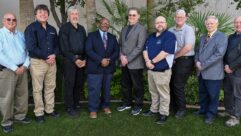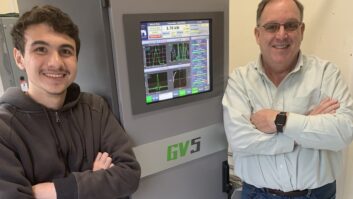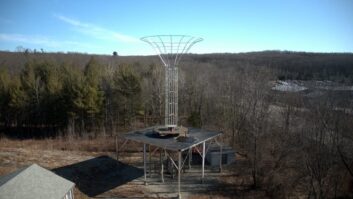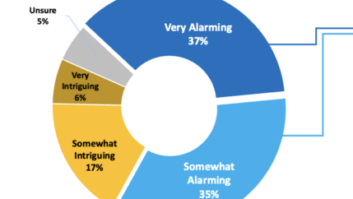AFRTS is the American Forces Radio & Television Service. There are some in our industry have roots to AFRTS in both the technical and on-air side … including people like Pat Sajak to Adrian Cronauer (“Good Morning, Vietnam”). This year AFRTS celebrates 75 years of providing “a touch of home” to the men and woman of the U.S. Armed Forces overseas (and a few U.S.-based as well). AFRTS has its roots in Kodiak, Alaska, at Fort Greely with KODK prior to the inception of AFRS (before adding TV, the letters were simply AFRS). Recognizing that these radio stations were of benefit to the morale of the service members and a great way of disseminating information (who would have thought radio could do THAT?!), the War Department of the United States established AFRS in 1942 (later adding the TV “T” in 1954 when they launched a test TV station in 1954 in Maine).

AFRS began with its first network, the Armed Forces Network (AFN), in Munich, Germany, in 1945. After that, AFRS grew with other “networks” across the world. When I served in the Air Force from 1986 to 1990, we had different networks including the one I worked for, “EBS” (not Emergency Broadcast System as most knew those letters, but European Broadcast Squadron). EBS included Turkey, Spain and Greece. We also still had AFN which was mostly Germany. And there was FEN, the Far East Network in Japan. We also had AFKN, the Armed Forces Korean Network, AFVN, the Armed Forces Vietnam Network and AFTN, the Armed Forces Thailand Network. Basically whatever geographical region the U.S. had military members (whether in a skirmish or just a group of peace-time bases), we had a network (including one in the Middle East when Desert Storm/Desert Shield kicked up).
There are a few good books about AFRTS (like “Brass Button Broadcasters,” 1992, by Trent Christman), plus movies with references to AFRTS or the most well-known, “Good Morning, Vietnam” with Robin Williams. In 1980 that was even a VERY short-lived TV series (six episodes) of a AFVN station during Vietnam called “The Six O’Clock Follies,” with a cast that actually included a young Laurence Fishburne, Bill Paxton, and even pre-SNL Phil Hartman. Alas, the plug was pulled before it could garner an audience (the success of “M*A*S*H” is understood to be the reason why this series was created; had it followed “Good Morning, Vietnam,” released in 1987, who knows the outcome).
You should note that AFRTS is sometimes simply referred to as AFN (Armed Forces Network) since the first official station was an AFN station. If it sounds confusing, just think of AFRTS being the network operations for all the different regional networks around the world. AFRTS has a broadcast center (BC) which originates a lot of the programming, but stations still run content locally as well (just like commercial radio and TV networks). Unlike U.S. commercial networks, the big difference is AFRTS does not air commercials as they could be construed as an endorsement by the U.S. government (which, of course, is “the owner” of AFRTS) … plus AFRTS stations use programming from every civilian broadcast network and every studio … so there is no “affiliation” to any content provider.
I could write a small book about my experiences in AFRTS/EBS. It was incredibly fun and always interesting. Though I was in the Air Force, AFRTS has military members from each branch and even include AFRTS stations on aircraft carriers and the larger Navy ships (which, at the time, had turntables on gyros so they’d stay level and the tone arm wouldn’t shift off the records when the ship rolled, no kidding!) The branch of the service affects the jobs AFRTS members take on. For instance, Navy broadcasters must take on the role of a fireman or munitions person in actual combat. However, for Airmen such as myself, our job in case of actual combat, such as the base coming under attack, was to continue to “spin records” or air “Days of Our Lives on TV.”
I was stationed at the now-closed Torrejon Air Base, just to the east of Madrid by about 10 miles or so. Beautiful weather, incredible culture, nice people, awesome city (especially for a kid from Dover, Ohio, with 13,000 people!).
AFVN
If you’ve seen “Good Morning, Vietnam” with Robin Williams, you have a pretty good idea of what the Armed Forces Vietnam Network was like. When I was in the Air Force, I spoke with military friends (older than me) who were actually stationed with AFVN in late ’60s early ’70s, and they said the big difference is the movie ignored the TV station aspect of AFVN and strictly presented it as radio-only, though both existed. Here’s a recording of AFVN radio which is interesting to hear.
Radio First Termer with Sergeant Dave Rabbit
In most instances, AFRTS is the only operation related to our military overseas, but during Vietnam, there was a “pirate” choice called Radio First Termer with “Dave Rabbit.” Though “Dave” passed away a few years ago, watching this video first will tell you the story in his own words. Radio First Termer was MUCH different from AFRTS in the sense that he could PLAY what he wanted … and SAY what he wanted! When you hear the audio of Radio First Termer (next link), you’ll understand. There is an NSFW warning for these. Let’s start with the background on this link.
Radio First Termer (As It Was Broadcast)
Fortunately, some listening post or outpost in Vietnam had the ability to record Radio First-Termer when it was broadcast. Here’s about an hour of the show as it was picked-up from an FM tuner into a reel-to-reel recorder.
The Story of AFRTS (From 1962)
In 1962, for the 20th anniversary of AFRTS, a film was produced starring actor Glen Force. This documentary explains the history of the American Forces Radio & Television Service.
More About AFRTS
Here’s another feature that talks about AFRTS and its history. It aired in 1988 on the program “For Veterans Only.”
AFRTS System Cue & Old ’70s Jingle
When I worked for AFRTS/EBS in Torrejon, my career was as a “broadcaster” (on-air type), but our command in Germany actually authorized me to also work as an engineer (which was a different career field and different tech school). For me, it’s interesting to hear and see these old system cues and jingles, even the ones before my time. AFRTS uses system cues like network stations in the U.S. use (like the NBC flying peacock indicating “you should have already been inserting commercials here!”).
All Things AFRTS
My fellow “AFRTS alumnus” Thom Whetston is the keeper of all things AFRTS. Though I’ve posted this link before, it’s worth posting again due to the content and nature of this OTBP. Thom has a lot of the history and recording from AFRTS on his blog.
And Finally…
AFRTS military personal generally don’t have “front line jobs” (I joked that I don’t think they would have let me have a gun unless I kept my bullets in my pocket like “Barney Fife”), and sadly there have been AFRTS personnel killed in the line of duty. But one of the most tragic events was at Udorn, Thailand, which was part of AFTN/Armed Forces Thailand Network. On April 17th, 1970, a returning damaged F-4 overshot the runway, crashing into several buildings on the base and completely destroying the radio and TV station, killing all nine on duty that day. Here are links related to this sad story.
A recollection from Jim Treat on his report from that day.
This memorial for those who died is from a VFW post.
And finally, this link including photos of the station while in operation (including their studios and people), and the pictures of the crash and destruction (scroll down).
If you stumble across a good or unusual website that might be of interest, please don’t hesitate to send me the link and any info you might have about it.My email address is [email protected].











